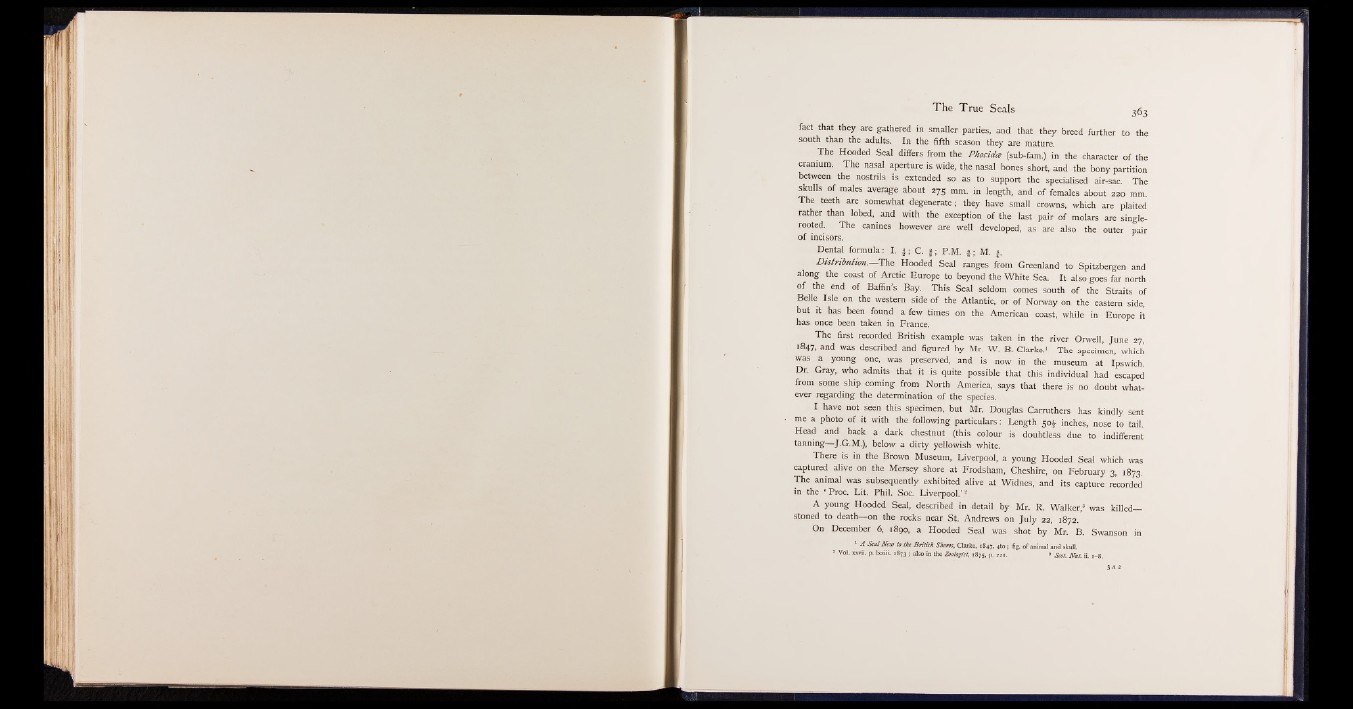
The True Seals 363
fact that they are gathered in smaller parties, and that they breed further to the
south than the adults. In the fifth season they are mature.
The Hooded Seal differs from the Phocida (sub-fam.) in the character of the
cranium. The nasal aperture is wide, the nasal bones short, and the bony partition
between the nostrils is extended so as to support the specialised air-sac. The
skulls of males average about 275 mm. in length, and of females about 220 mm.
The teeth are somewhat degenerate; they have small crowns, which are plaited
rather than lobed, and with the exception of the last pair of molars are single-
rooted. The canines however are well developed, as are also the outer pair
of incisors.
Dental formula: I. C. §; P.M. M. f
Distribution.— The Hooded Seal ranges from Greenland to Spitsbergen and
along the coast of Arctic Europe to beyond the White Sea. It also goes far north
of the end of Baffin’s Bay. This Seal seldom comes south of the Straits, of
Belle Isle on the western side of the Atlantic, or of Norway on the eastern side,
but it has been found a few times on the American coast, while in Europe it
has once been taken in France.
The first recorded British example was taken in the .river Orwell, June 27,
1847, and was described and figured by Mr. W. B. Clarke.1 The specimen, which
was a young one, was preserved, and ’JiS now in the museum at Ipswich.
Dr. Gray, who admits that it is quite possible that this individual had escaped
from some ship coming from North America, says that there is’ no doubt whatever
regarding the determination of the species.
I have not seen this specimen, but Mr. Douglas Carruthers has kindly sent
me a photo of it with the following particulars: Length 504 inches, nose to tail.
Head and back a dark chestnut (this colour is doubtless due to ihtifferent
tanning— J.G.M.), below a dirty yellowish white.
There is in the Brown Museum, Liverpool, a young Hooded Seal which was
captured alive on the Mersey shore at Frodsham, Cheshire, on February 3, 1873.
The animal was subsequently exhibited alive at Widnes, and its capture recorded
in the ‘ Proc. Lit. Phil. Soc. Liverpool.’ 2
A young Hooded Seal, described in detail by Mr. R. Walker,8 was k illed -
stoned to death— on the rocks near St. Andrews on July 22, 1872.
On December 6, 1890, a Hooded Seal was shot by Mr. B. Swanson in
1 A. SealNew i0 the British Shores, Clarke, 1847, 4 to; fig. of animal and skull.
* VoL xxvii. p. lxxiii. 1873; also in the Zoologist, 1875, p. 221. * Scot. Nat. ii. 1-8.
3 a 2